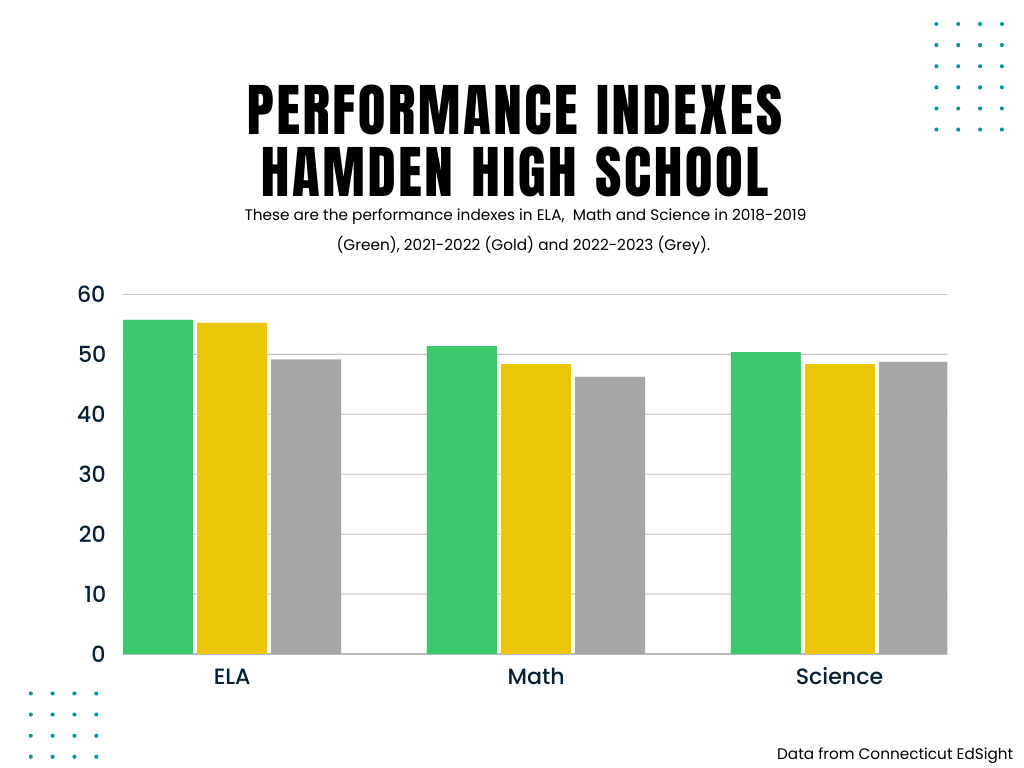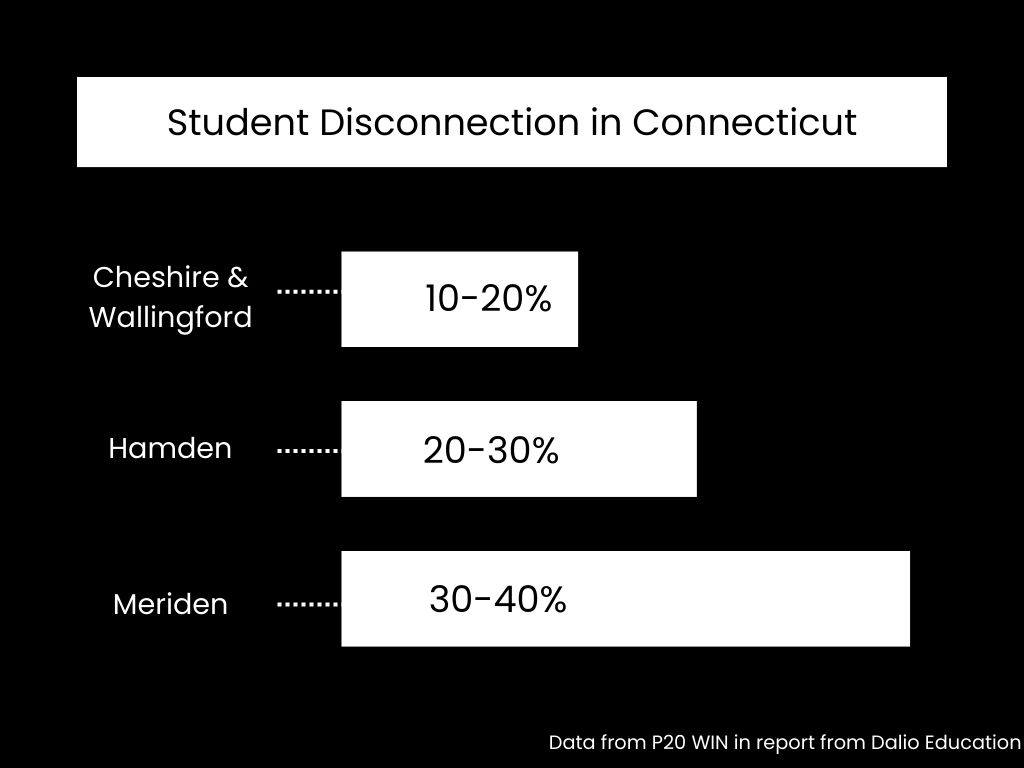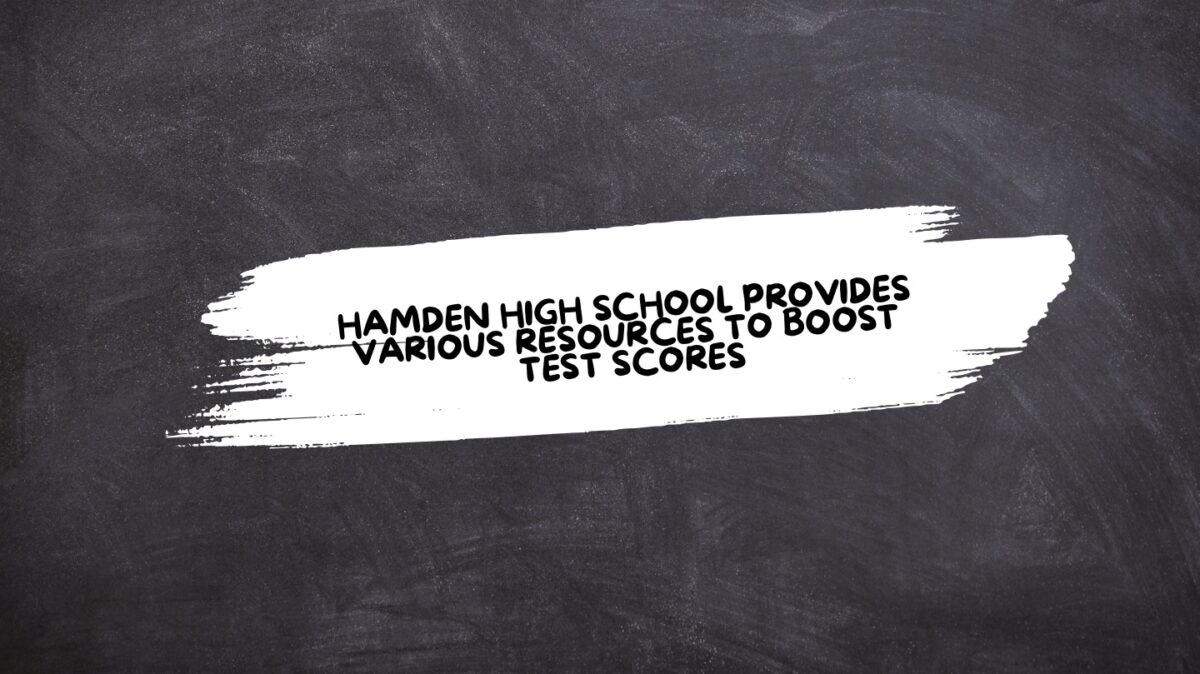Hamden public schools are working to provide resources for students after the COVID-19 pandemic to help improve mental health and increase test scores since students are still adjusting to being back in the classroom.
Faced with declining scores in English Language Arts, math and science, Hamden is providing counselors, tutors and instruction time to students at risk of falling behind. But it needs to do so within its existing education budget.
On a performance index that rates student’s scores, Connecticut’s target is 75 out of 100, according to Connecticut EdSight.
Hamden High School’s scores slipped in ELA from 55.8 in the year before the pandemic to 49.2 in the current school year. Their scores in math declined from 51.4 in the year before the pandemic to 46.3 in the current school year. Additionally, their scores in science decreased from 50.4 before the pandemic to 48.8 in the current school year, according to Connecticut EdSight.

In neighboring Cheshire, a wealthier town, scores also decreased with the pandemic, but at least in science, have largely rebounded.
Cheshire High School, in the 2018-2019 school year scored 67.9 in ELA, 66.4 in math and 69.5 in science. In the 2021-2022 school year, CHS’s scores were lower—65.1 in ELA, 63.0 in math and 65.5 in science. In the 2022-2023 school year, they had dropped further to 63.1 in ELA, 62.1 in math but increased to 68.9 in science, according to Connecticut EdSight.

Linda Tran, the assistant superintendent of secondary education in Hamden said that at the district leadership level, they have dived into the updated test scores but that the pandemic is still hindering students.
“We still are feeling the impact of the pandemic and the loss of instructional time,” Tran said. “The pandemic had to pretty much force schools to shift our modes of instruction. As much as we want to say that all of our schools and school districts did a good job of shifting, there is nothing that is comparable to in- person instruction.”
Additionally, Tran said the pandemic taxed student and the staff mental health limiting socialization crucial to students learning to interact with their peers.
“We are spending a lot of time to reteach some of those executive functioning and social skills that prior to the pandemic, students came to us having,” Tran said.
The district leadership team on Oct.12 presented its plans to address the test score decline to the Board of Education. An initial review of the test scores showed success in some areas, Tran said.
To address the mental health challenges that the pandemic created, all the secondary schools have school-based health clinics serviced by Cornell Scott-Hill Health Center, Tran said. There is also mental health support for students and families from Clifford Beers. She said the district has allocated a significant number of resources to offer these services to students referred for help.
To better understand a student’s social and emotional needs, the district uses the DESSA, Devereux Student Strengths Assessment, an inventory that high school students can complete or that teachers can fill out for them. Each school then uses this data to refer individual student’s to social work, administrative or other support through the Clifford Beers or Cornell Scott-Hill clinics, Tran said.
Hamden has “revamped and increased” their academic support, so there is a “robust and comprehensive” Scientific Research Based Intervention (SRBI) team that is lead by a district administrator, said Tran.
Data from the last several years showed which students need more help.
High school students behind in math and English can take courses with more class time, a co-teacher or a tutor, said Tran.
Tran emphasized the importance of making students aware of the available resources so that students can make use of them.
“I think our students at the high school are very vocal and the culture and the climate at Hamden High School is one where students know that it is safe that they can advocate for themselves,” Tran said.
Beyond test scores, Hamden is looking at students’ plans to go to college or pursue other pathways.
Melissa Kaplan, chair of the Hamden Board of Education said that since the pandemic, Hamden has been hit “particularly hard” in terms of job, food and housing insecurity within the student population.
“We are also seeing teachers leaving the workforce in numbers,” Kaplan said. “There is a lot of instability in terms of maintaining the level of engagement in the classroom but also having that continuity of instruction.”
Kaplan said that after the pandemic there has been an increase in students diagnosed and have federal 504 plans and have Individualized Education Plans, which cater to the specific academic needs of each student. She said that Hamden has increased hiring of special education teachers
“Having coordinators that focus on making sure that our students, particularly our neuro-diverse students also have a great advocate for them in the schools,” Kaplan said. “And making sure that since we are obligated to meet their needs that we make sure that we do so.”
Hamden’s already high tax rate makes it hard to raise the extra resources needed to fully meet its needs.
Kaplan said the district was trying to use its money wisely and strategically to focus on student needs.
“If they’re taken care of, then we know that they are going to learn much better when they’re safe and secure and their well- being is again nurtured,” Kaplan said.
Some students go to school worried about where their next meal is going to come from, where they are going to sleep that night or at home conflicts that interfere with sleeping.
“When we’re looking at the whole child and taking care of all the needs of the students, we can get them to engage in the classroom and get them engaged in their own education,” said Mayor Lauren Garrett. “So, our partnership with Clifford Beers is really important to help us with that.”
Across Connecticut, there are 63,000 kids already disconnected and other 56,000 at-risk of becoming so, according to a 2022 report by the Boston Consulting Group. The report, commissioned by Dalio Education, noted that these 119,000 kids or 19% of the total number of kids aged 14 to 26 revealed a “crisis.”
In a map of youth age 14-26 showing levels of disconnection throughout Connecticut, Hamden is at greater than 20-30% disconnected, higher than wealthier neighboring Cheshire and Wallingford with less than 20% but lower than Meriden, which has 30-40% disengaged according to P20 WIN in the report from Dalio Education.

“We need to improve those numbers and a lot of that work is in making sure we’re taking care of the whole child,” Garrett said. “Checking in on mental health, checking in on what a student needs to succeed, maybe it’s a bed, maybe it is food for their family. We’re not just looking at one student out of a family. What’s going on with the entire family?”
Eric Jackson, new principal of Hamden High School principal said he spent his first 90 days understanding the school culture, their programs and the people. He wants to make sure HHS follows the district’s goals including “clarity of practice.”
“We want to make sure that our teachers are providing our students with a roadmap so that students understand what they’re learning, why they’re learning it and what the process is that gets them to a place that they understand what success looks like,” Jackson said.
The second goal of this plan is student engagement, said Jackson.
“We want to make sure that our teachers feel very comfortable in releasing that responsibility of learning on to our students,” he said to enable them to have “deeper conversations and really construct meaning on the concepts they are studying.”
The third goal is feedback, said Jackson.
“We want to make sure that when our students are given tasks, given assignments, given opportunities to apply their learning, that our teachers are providing timely and specific feedback that’s helpful to them when they need to make corrections or make adjustments in their learning,” Jackson said.

The Hamden Board of Education has also been working to increase the number of diverse faculty members within the schools over the last several years.
Mariam Khan, Hamden Board of Education’s equity chair and Hamden High School alumna, was a student representative for two years in high school before become a board member.
“One of the biggest things a lot of students really rallied behind for several years was having staff that was more representative,” Khan said.
In the 2020-2021 school year, 28% of the staff in Hamden public schools were teachers of color and all teachers of color hired during the 2019-2020 school year continued to work in 2020-2021, according to Hamden Public Schools. In 2021-2022 Hamden started participating in The CREC Teacher Residency Program which works to seek out and retain teachers of color, according to Hamden Public Schools.
“When we talk about the teacher shortage and why we don’t have enough minority teachers, I think we really need to have a candid conversation about the climate that teachers have been put in right now,” Khan said. “I think another big part …isn’t just creating pipelines, but making education a genuinely rewarding and empowering experience for black and brown students, for students with disabilities, for students from those marginalized backgrounds.”
Hamden public schools are working to provide resources to students at risk of falling behind, dropping out or struggling to find jobs after graduation. The town will continue to provide these various resources to students in an effort to improve scores for assessments in the future and make up for some of the setbacks that the pandemic caused.

